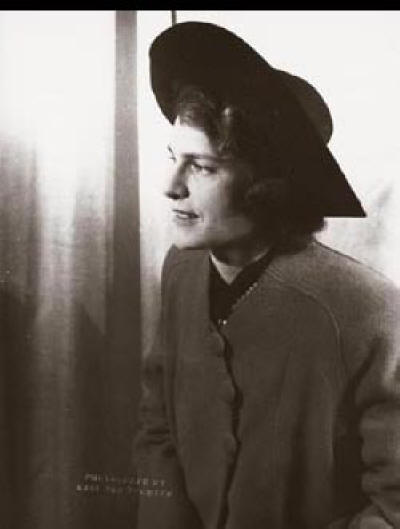

Queer Places:
Columbia University (Ivy League), 116th St and Broadway, New York, NY 10027
Cornell University (Ivy League), 410 Thurston Ave, Ithaca, NY 14850
Chrysler Building, 405 Lexington Ave, New York, NY 10174
 Margaret Bourke-White (/ˈbɜːrk/; June 14, 1904 – August 27, 1971) was an American photographer and documentary photographer.[1] She is best known as the first foreign photographer permitted to take pictures of Soviet industry under the Soviet's five-year plan,[2] the first American female war photojournalist, and having one of her photographs (the construction of Fort Peck Dam) on the cover of the first issue of Life magazine.[3] She died of Parkinson's disease about eighteen years after developing symptoms.
Margaret Bourke-White (/ˈbɜːrk/; June 14, 1904 – August 27, 1971) was an American photographer and documentary photographer.[1] She is best known as the first foreign photographer permitted to take pictures of Soviet industry under the Soviet's five-year plan,[2] the first American female war photojournalist, and having one of her photographs (the construction of Fort Peck Dam) on the cover of the first issue of Life magazine.[3] She died of Parkinson's disease about eighteen years after developing symptoms.
Among the best-known photographers of her time, Margaret Bourke-White recorded the physical and social landscape of the first half of the twentieth century, exploring the mechanical as well as the humanistic in American culture. Industrial and architectural subjects dominate her early work, though she would later become interested in photographing people as well as machines. Bourke-White also became a leading photojournalist in Europe during World War II.
Though she set out to concentrate on the biological sciences, as a student at Columbia University Bourke-White studied photography under Clarence H. White, a photographer associated with Alfred Stieglitz and his circle. In spite of her increasing interest in pursuing photography, Bourke-White left Columbia after just one year. She attended a number of schools before earning a degree in biology from Cornell University in 1927. To support herself at Cornell, Bourke-White began taking photographs of the campus and selling them to other students and to alumni. During this time, she became a skilled architectural photographer and decided to pursue a career in the field.
By 1929, Margaret Bourke-White had moved to New York City and taken a photographer’s position with a new business magazine, Fortune. In 1930, Fortune sent her to the Soviet Union where she was to do a story on Russian industrialization. Bourke-White’s photographs from this trip presented a more wide-ranging and thorough photographic record of the Soviet Union than Americans had seen before. These photos of Soviet Russia were collected as Bourke-White’s first book, Eyes on Russia (1931).
By the mid-1930s, Bourke-White’s photographs focused less on the industrialization of America and she began to use her camera to document other, more human aspects of modern life. In 1934, she covered the Dust Bowl, the severe drought and dust storms, or “black blizzards,” that crippled the Plains states for the first half of the decade.
Her interest in documenting human experience led to Bourke-White’s first collaboration with Erskine Caldwell, the 1937 book Have You Seen Their Faces, which used both text and photographic images to detail the lives of sharecroppers in the American south. Though Bourke-White and Caldwell married in 1939, they remained together for only three years. Despite their failed union, they collaborated on two additional projects: North of the Danube (1939) and Say, Is This the USA (1941). Her collaborations with Caldwell were very well received, and Have You Seen Their Faces is still considered one of her most important works.
During World War II, Bourke-White returned to the Soviet Union to cover the war there for Life Magazine. When the Germans invaded in January 1941, Bourke-White was the only American photographer in the country and so was able to provide exclusive photos of the Soviet War for the magazine. As a war correspondent, Bourke-White did not yield to discriminatory practices that often held women reporters back; as a result of her determination she became the first woman to accompany a United States Air Force bombing mission.
Margaret Bourke-White is known equally as an artist (Alfred Stieglitz is said to have called her “one of the world’s great artists”) and as a journalist who documented the social and industrial landscape of her day.
In 1953, Bourke-White developed her first symptoms of Parkinson's disease.[5] She was forced to slow her career to fight encroaching paralysis.[3] In 1959 and 1961, she underwent several operations to treat her condition,[5] which effectively ended her tremors but affected her speech.[3] In 1971, she died at Stamford Hospital in Stamford, Connecticut, aged 67, from Parkinson's disease.[4][5][19] Bourke-White wrote an autobiography, Portrait of Myself, which was published in 1963 and became a bestseller, but she grew increasingly infirm and isolated in her home in Darien, Connecticut. In her living room, there "was wallpapered in one huge, floor-to-ceiling, perfectly-stitched-together black-and-white photograph of an evergreen forest that she had shot in Czechoslovakia in 1938". A pension plan set up in the 1950s, "though generous for that time", no longer covered her health-care costs. She also suffered financially from her personal generosity and "less-than-responsible attendant care."[3]
My published books: